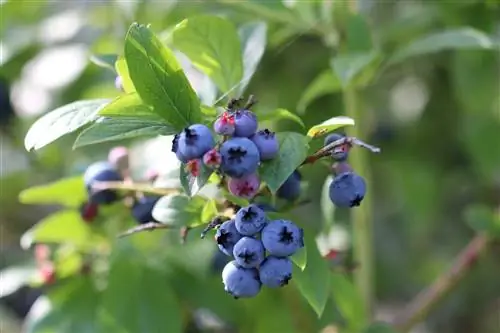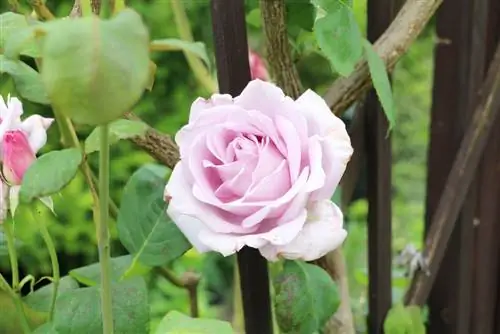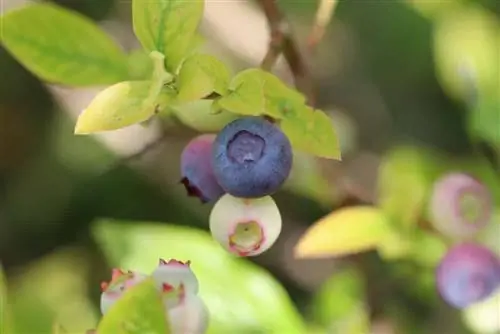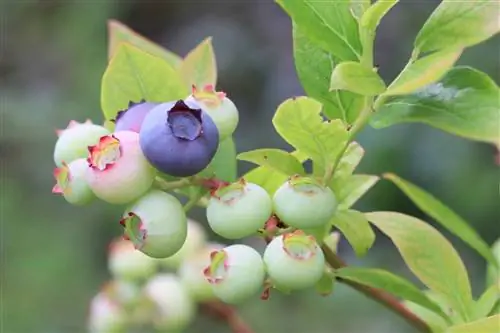- Author admin [email protected].
- Public 2023-12-17 03:39.
- Last modified 2025-01-24 12:45.
The garden blueberry tastes very good, has many uses in the kitchen and is also very he althy. The garden blueberry can also serve as a privacy screen if it is used as a palisade planting. So why not plant your own garden blueberries in your own garden? With a little background knowledge, planting and care can be achieved optimally.
By the way: When consumed, the garden blueberry has the advantage that it does not discolor the mouth and teeth. This is because it is not related to the native blueberries that grow wild in the forests, but is a relative of the American blueberries.
Varieties
There are now more than 100 new varieties of garden blueberries that have been cultivated since the beginning of the 20th century. In Germany, the breeder Wilhelm Heermann cultivated the blue-white gold grape and the blue-white sugar grape, from which the varieties Blau-Weiß-Goldtraube 71 and Rekord were later selected as additional varieties. The varieties Herma I and Herma II as well as Gila and Greta have become established in Germany. What all of these varieties have in common is that they thrive optimally in German climatic and soil conditions.
Many varieties of garden blueberries are mainly known in the USA. The Bluerose as well as the Marus and the Rahi, which come from Australia and New Zealand and therefore thrive best in this climatic environment, are known as crosses. In total, around 30 cultivated garden blueberry varieties are established worldwide and are widely cultivated. Practically the only garden blueberry that has been able to establish itself worldwide is the Bluecrop, which is because it delivers high and regular yields even in very different locations and different conditions. In addition, this variety is cold-hardy and drought-tolerant and is also very resistant to pests and diseases.
Location Requirements
The garden blueberry is very popular for the orchard in our latitudes, but it has special demands on the location and also the soil. Since the plants botanically belong to the heather family, a humus-rich, lime-free and evenly moist soil is the ideal location. Sometimes it may prove easier to grow the blueberry in a container to provide it with the perfect soil conditions. In this case, ready-made ericaceous soil is filled into the bucket because it best meets the needs of the blueberries. But it is also possible to bury a bricklayer's bucket in the garden and then plant the blueberries in it with an optimal substrate. So that the pH value of the soil is not increased unnecessarily, which the garden blueberry likes less, it is recommended to water the plant with rainwater, because the lime content in tap water unnecessarily increases the pH value of the soil. In addition, the lime from the tap water hinders the growth of the garden blueberries. Garden blueberries also appreciate partner planting. Even though cultivated blueberries are self-fertile plants, it is still recommended to plant at least two different varieties together in order to increase the fruit yield. Demands of the garden blueberry on the location:
- humus-rich, lime-free or lime-poor, moist soil
- for perfect conditions: plant as a pot plant with ericaceous soil
- for low pH values, if possible, only water with rainwater or low-lime water
Plant correctly
If the garden blueberry is planted, you should use loose soil, incorporate plenty of moisture and also plant the plant carefully. The nutrient balance, which is achieved through targeted and regular fertilization, is also important for perfect growth and a good fruit yield. The choice of location and substrate lays the foundation for the fruit yield. In the wild, blueberries usually grow in moist moorland meadows and in the undergrowth of sparse moorland forests. Because the roots of the shrubs are not deep, but rather spread out shallowly, the plants should also be planted in a planting hole that is not too deep and has a large diameter in your own garden.
Substrate
Loose soil that is permeable and does not tend to become muddy or compacted is the ideal substrate for the garden blueberry. A mix of garden soil and compost, leaves or sand is perfect. The plant grows and thrives better the looser and more permeable the substrate is to oxygen. Low-lime substrate is important because too much lime robs the roots of the blueberry from the ability to absorb nutrients that are important to them. If yellow leaves are present, this can indicate an imbalance and an increased lime content in the soil if fertilization is optimal.
Tip:
If you are not sure whether the selected soil is low in lime, you can check its lime content using test strips available in garden centers or hardware stores.
Care
The blueberry plants require good, sensitive care for a rich fruit yield, which should not only be limited to the harvest time.
Cutting
Consistent pruning of the plant is not necessary, but it will not harm it if necessary. If the plant is too large or dense for your own garden conditions, you can remove some of the shoots in order to thin out the plant. When the plant is four to five years old, old branches should be cut out so that the garden blueberry experiences rejuvenation. To do this, the old branches are cut out directly above the ground. This pruning from the age of four to five is important because without pruning only a few new shoots will develop from the plant and the harvest will therefore be reduced. Pruning should be done during the winter months, when the leaves have completely fallen off but no new growth has occurred. The temperature should be below freezing when pruning.
When pruning, the old shoots are first removed directly above the ground. Each shrub only needs around six shoots to develop perfectly and produce new shoots. Shoots that developed poorly last season and produced unripe berries should also be removed. Furthermore, when cutting, the side shoots are thinned out in order to give the plant more sunlight and thus better ripened berries. Note that the cut
- not necessarily consistent pruning is required
- can take place without any problems if growth is too strong
- can be done regularly and moderately from the age of four to five years
- should always be done within the winter months after the leaves have fallen and before sprouting
Frequently asked questions
My garden blueberries are so sour, is that normal?
The fact is that garden blueberries become sweeter the longer they are allowed to stay on the bush. The harvest time is between mid-July and the end of August. Important to know: Garden blueberries ripen gradually and so only the ripest fruits on a bush should be picked, which then have the right amount of sweetness. It should be borne in mind that a garden blueberry only produces the highest yield of fruit after six years. However, the plant can produce fruit for decades overall.
Can I propagate my garden blueberries myself?
The garden blueberry can be easily propagated using so-called lowering plants. To do this, a shoot is bent onto the ground and fixed there within the soil. If the shoot has developed its own roots, it can be separated from the mother plant and planted elsewhere.
What you should know about garden blueberries in brief
Claims
- The garden blueberry only grows on acidic soil with a pH of 4 to 5.
- In order to determine the pH value of your own garden soil, you can buy small test strips commercially that can be used to examine a soil sample.
- The soil is then adapted to the needs of the blueberries, because in most cases the measured pH value will be higher.
- To do this, either peat or ericaceous soil is worked into the soil, after which planting can begin.
Care
- Garden blueberries need a sunny and somewhat sheltered place in the garden, where the soil is always slightly moist.
- To avoid having to water constantly, it is helpful to cover the soil around the plants with a layer of bark mulch, leaves or sawdust.
- As soon as flowers form, however, ensure sufficient watering. When it is dry, the berry drops leaves, flowers and also fruits.
- Basically, it is not necessary to plant several varieties because almost all varieties of garden blueberries are self-pollinating.
Bucket keeping
- Because blueberries require very special soil, it may be easier to cultivate them in a container.
- It is best to fill this bucket with finished bog soil, which best meets the needs of the blueberries.
- It is also possible to bury a large container such as a bricklayer's bucket in the garden and plant the blueberries there.
- In order not to increase the pH value of the soil again, garden blueberries should only ever be watered with rainwater.
Cutting
- Pruning the blueberry is not necessary, but it won't do any harm either.
- If the plant has become too big or too dense, you can remove some shoots to thin it out a little.
- However, after about four to five years, you should start cutting out the oldest branches to rejuvenate the plant.
- These branches are cut off just above the ground.






